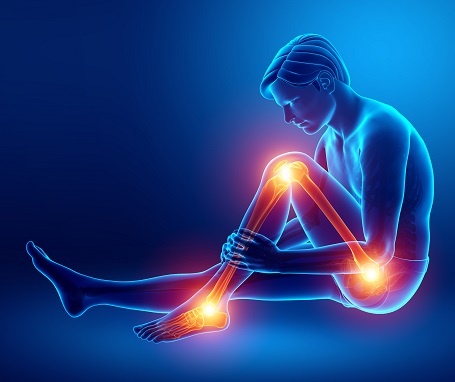Rheumatoid Arthritis
What is rheumatoid arthritis?
The most common cause of chronic inflammatory joint disease, Rheumatoid arthritis (RA) is an autoimmune condition under which the body’s immune system which is meant to protect your body’s health, starts attacking the joints mistakenly. The pain and stiffness caused due to RA usually occurs on both sides of the body symmetrically. In other words, if one of your knee joints is affected due to RA, the similar joint on the other knee will be affected too. Rheumatoid arthritis is a systemic disease and changes can be widespread in a number of tissues. RA usually affects joints of hands, feet, wrists, elbow, knees and ankle.
Cause
The cause of RA is not fully known. However, a great deal is now known about the circumstances in which RA develops, and hypotheses about its aetiology and pathogenesis have been suggested. Important factors in the evolution of RA are:
(1) Genetic susceptibility
(2) An immunological reaction, possibly involving a foreign antigen, preferentially focused on synovial tissue
(3) An inflammatory reaction in joints and tendon sheaths
(4) The appearance of rheumatoid factors (RF) and anti-citrullinated antibodies (anti-CCP or ACPA) in the blood and synovium
(5) Perpetuation of the inflammatory process
(6) Articular cartilage destruction.
Symptoms
The symptoms of RA include:
- Joint pain
- Joint tenderness and swelling
- Similar joint on both sides of the body is affected
- Usually small joints are affected
- Increased stiffness in the morning
Clinical features
The onset of RA is usually insidious, with symptoms emerging over a period of months. Occasionally the disease starts quite suddenly.
In the early stages, the picture is mainly that of a polysynovitis, with soft-tissue swelling and stiffness. Typically, women of 30-40 years complains of pain, swelling and loss of mobility in the proximal joints of the fingers. There may be a previous history of ‘muscle pain’, tiredness, loss of weight and general lack of well-being. As time passes, the symptoms spread to other joints-the wrists, feet, knees and shoulders in order of frequency. Another classic feature is generalized stiffness after periods of inactivity, and especially after rising from bed early in the morning. This early morning stiffness typically lasts longer than 30 minutes.
Physical signs may be minimal, but usually there is symmetrically distributed swelling and tenderness of the metacarphalangeal joints, the proximal interphalangeal joints and the wrists. Tenosynovitis is common in the extensor compartments of the wrist and the flexor sheaths of the fingers; it is diagnosed by feeling thickening, tenderness and crepitation over the back of the wrist or the palm while passively moving the fingers. If the larger joints are involved, local warmth, synovial hypertrophy and intra-articular effusion may be more obvious. Movements are often limited but the joints are still stable and deformity is unusual.
Diagnosis
The usual criteria for diagnosing rheumatoid arthritis are the presence of a bilateral symmetrical polyarthritis involving the joints of the hands or feet, and persisting for at least 6 weeks. If there are subcutaneous nodules of X-ray signs of periarticularerosions, the diagnosis is certain. A positive test for RF in the absence of the above features is not sufficient evidence of rheumatoid arthritis, nor does a negative test exclude the diagnosis if the other features are all present. The chief value of the RF tests is in the assessment of prognosis: persistently high titres herald more serious disease including extra-articular features.
Treatment
There is no cure for rheumatoid arthritis. However, advances in therapy have revolutionized the treatment approach with associated major improvements in outcome. Medical treatment is guided by the principle that inflammation should be reduced rapidly and aggressively.
At the onset of the disease, both the patient and the doctor will be uncertain about the likely rate progress. An attempt should be to determine the likely prognosis (forecast of the likely outcome). Poor prognosis is associated with female sex, multiple joint involvement, high ESR and CRP, positive RF and anti-CCP, younger age, high BMI, smoking and the presence of erosions at diagnosis.
Principles of medical management
- Treatment should be aimed at controlling inflammation as rapidly as possible. This is likely to require the use of corticosteroids for their rapid onset (initially oral doses of 30 mg of prednisolone or 120 mg i.m. methylprednisolone may be used).
- Steroids should be rapidly tapered to prevent significant side effects.
- In addition, disease-modifying antirheumatic drugs (DMARDs) should be started at this time. The first choice is now methotrexate at doses of 10-25 mg/week. This may be used initially alone or in combination with sulphasalazine and hydroxychloroquine. Leflunomide can also be considered if methotrexate is not tolerated. Gold and penicillamine are associated with significant side effects and are now used very rarely.
- Control of pain and stiffness with non-steroidal anti-inflammatory muscle tone and joint mobility by a balanced programme of exercise is prescribed. General advice on coping with the activities of daily living is given.
Physiotherapy and occupational therapy
Preventive splinting and orthotic devices may delay the march of events. However, it is important to encourage activity. If these fail to restore and maintain function, operative treatment is indicated.
Prognosis
Rheumatoid arthritis runs a variable course. When the patient is first seen, it is difficult to predict the outcome, but high titres of RF and anti-CCP, periarticular erosions, rheumatoid nudules, severe muscle wasting, joint constractures and evidence of vasculitis are bad prognosis signs. Women, on the whole, fare somewhat worse than men.
Without effective treatment, about 10% of patients improve steadily after the first attack of active synovitis; 60% have intermittent phases of disease activity and remission, but with a slow downhill course over many years; 20% have severe joint erosion, which is usually evident within the first 5 years; and 10% end up completely disabled. In addition, a reduction in life expectancy by 5-10 years is common and is often due to premature ischaemic heart disease. However, early aggressive medical treatment appears to reduce the morbidity and mortality.

